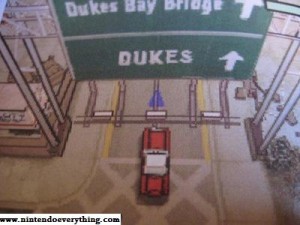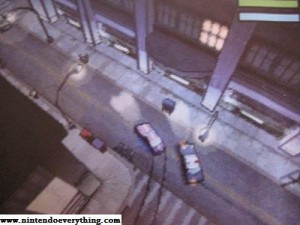Rockstar's Gordon Hall recently spoke with 1UP about the company's Nintendo DS edition of Grand Theft Auto, revealing many more details about the intriguing project. Whilst many believe the game is simply using an isometric camera viewpoint, Hall points out that:
Actually, the game isn't really isometric; it's true 3D through and through. What we've done is place the camera pretty high up during most of the gameplay. There are many reasons for this -- some visual so you get a sense of movement and scale, some regarding the technicalities of the hardware and how many polygons the DS can display -- but the main reason for this decision is one of gameplay. Right from the very start, we decided to make the game as fun as possible for the platform, even if that meant it lent more toward an arcadey experience, as we all agreed this would work best on a DS. With this type of hardware, we felt it was important that the player had a good view of the action at all times.
As for the cel-shading aspect of the game's graphics, Hall revealed it was done to help give the game is own art style, taking advantage of what the system has to offer in comparison to other, more powerful platforms, "This cel-shaded look is just one example of this happening. Another is the graphic-novel approach we took with the animated 2D cut-scenes. They're very GTA, yet feel almost Japanese in their style."
The game has been in development for two years now and has been worked on by a big team, with it actually being the biggest game Rockstar Leeds has done so far. As for "how it compares to the other games we've done -- in a way, this game's development cycle has been similar to Liberty City Stories and Vice City Stories in that we, at Rockstar Leeds, set out to really push ourselves, and the studio was given all the tools and support we needed to do the job by the rest of the company." He then points out that the main difference between those PSP games and this DS one is in the scale of the DS project, since it is more than 900,000 lines of hand-optimised code, set in a huge city. Great attention-to-detail has been given, with "street clutter and the ability to inflict damage to vehicles, through to the littlest directorial edits" being added meticulously in, with Hall believing it is actually the best game he has ever worked on.
In terms of the control system, the touch-screen is used "extensively" during Chinatown Wars. As Hall says,
During normal gameplay, the bottom screen controls your PDA. This gives you access to your GPS navigation system, which is nicely linked in to all your contacts and favourite locations around the city. Another key item on the touch screen is your e-mail system. Most of the contacts in the game will deal with you via e-mail in some way. Just two more examples of PDA use are monitoring your drugs empire or ordering weapons from Ammunation Online and having them delivered to one of your safe houses. The list goes on; it's a very integral part of the game.Outside of the PDA, you also use the touch screen to fill in those little details left out of most console games. You may find yourself in a minigame hotwiring a car or breaking into a warehouse by disabling a key-code lock. We also use the touch screen for more everyday events like buying and using [lottery] scratchcards. Everywhere it felt right to use the touch screen, we've done so.
To read more, be sure to check out the full interview.

 Sign In
Sign In 08.12.2008
08.12.2008 
 Game Details
Game Details
 Out now
Out now  Out now
Out now  Out now
Out now  Out now
Out now  h
h 
 Link to this post:
Link to this post: 

 Subscribe to this topic
Subscribe to this topic Features
Features






 Top
Top

